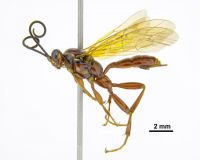ICHNEUMONIDAE: : Aucklandella Cameron 1909
Diagnosis:
The large diversity of species and variation in characters make Aucklandella difficult to identify.Characteristics of Aucklandella include: 1. Body size mostly ,10mm but occassionally 10-20mm; 2. Position of spiracle on T1 of metasoma clearly behind the centre; 3. Shape of aerolet in forewing pentagonal (closed); Colour of face variable; 5. Metasoma compressed dorsal-ventrally; 6. Size of ocelli small; 7. Length of antennae shorter than body; 8. Length of ovipositor always short, sometimes barely visible; 9. Wings mostly present, but sometimes very reduced (Brachypterous); 10. Colour of wings mostly clear but occassionally infusciate (darkened); 11. Sternaulus absent or short; less than 0.5x length mesopleuron; 12. Shape of face in lateral view usually flat or only weakly bulging but sometimes bulging (c.f. Metopiinae); 13. Sternite on T1 (viewed laterally) not extending past spiracle; 14. Shape of T1 (viewed laterally) evenly curved; 15. Number of teeth in mandibles 1 or 2; 16. Patterns on metasoma varaible - from the same colour throughout to coloured bands; 17. Length of T1 vs T2 subequal in length; 18. Sculpture on mesoscutum variable, smooth or finely pitted; 19. Width of T1 (viewed dorsally) anterior part slender often parallel, strongly widening behind spiracle; 20. Glymma on T1 absent; 21. Sculpture on metasoma variable; 22. Propodeum very short (not reaching beyond coxal insertion).
Similarity to Other Taxa
The shape of the aerolet in forewing (closed pentagonal) helps to narrow down the identificaton of the genus. However, there is great character variation in Aucklandella .Similar to many genera in the subfamily Cryptinae but these have the aerolet in forewing open pentagonal. Also some Cryptinae have the spiracle at T1 at, or before the centre (it is always after the centre in Aucklandella).
Compare
Distribution in NZ
North Island: ND, AK, BP, CL, GB, HB, TK, TO, WI, WN, WO. South Island: NN, NC, SD, BR, MB, MC, DN, CO, OL, WD, FD, SI, MK, SL. Offshore Islands: CH, AU.
Species in NZ
An endemic genus with approximately fifty species, including twelve currently recognised as valid: Aucklandella conspirata (Smith 1876); A. flavomaculata Cameron 1909; A. geiri (Dalla Torre 1902); A. hudsoni (Cameron 1901); A. machimia (Cameron 1898); A. minuta (Ashmead 1890); A. novazealandica (Cameron 1898); A. pyrastis (Cameron 1901); A. thyellma (Cameron 1898); A. ursula (Cameron 1898); A. utetes (Cameron 1898); A. wellingtoni (Cameron 1901).Biology & hosts
This endemic genus is found throughout New Zealand, and although commonly collected, Aucklandella are generally not caught in large numbers. Most species are brightly coloured and patterned (yellow, red, black).Little is known about their biology, although they are all thought to be parasitoids of Lepidoptera larvae or pupae. Host records include: Aucklandella conspirata and A. pyrastis have both been recorded from the Common Forest Looper, Pseudocoremia suavis (Geometridae), and A. ursula from Izatha attactella (Oecophoridae).
The large diversity of species and variation in characters make Aucklandella difficult to identify. This is unfortunate because they are a very widespread and abundant part of the New Zealand hymenoptera fauna. A revision of the genus is needed.
Sources of information
Berndt L, Berry J, Brockerhoff E. 2006. Parasitoids and predators of the endemic defoliator Pseudocoremia suavis (Butler) (Lepidoptera: Geometridae: Ennominae). New Zealand Entomologist, 29: 89-98.Gauld ID. 1984. An Introduction to the Ichneumonidae of Australia. London, British Museum (Natural History). 413 p.
Valentine EW & Walker AK. 1991. Annotated Catalogue of New Zealand Hymenoptera. DSIR Plant Protection Report 4. General Printing Services, 84 p.
Ward DF, Early JW, Schnitzler FR, Hitchmough RA, Stringer IAN. 2012. Conservation status of New Zealand Hymenoptera. New Zealand Entomologist 35 (2):116-119.
Citation
Ward DF & Schnitzler FR. 2013. Ichneumonidae of New Zealand. Genus Aucklandella http://ichneumonidae.landcareresearch.co.nzAccessed: 26 April 2025




